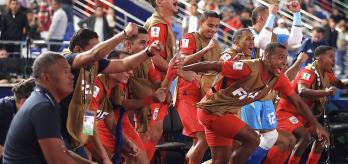In their opening match, Brazil registered 16 attacking corners – almost double the average for teams in the first round of FIFA Futsal World Cup Uzbekistan 2024™ and four more than the Seleção’s tournament average from FIFA Futsal World Cup Lithuania 2021™. Ali Targholizadeh, the TSG member who observed the match at Bukhara’s Universal Sports Complex, explains how this impressive tally is indicative of Brazil’s wider in-possession playing style, and reveals several of the elements that allowed the former champions to capitalise from these set-play situations.
The wider context of a high corner tally
How did Brazil register 16 corners in 40 minutes of play? A high corner tally is a common feature in Brazil’s games, as they often force their opposition into a low block for large periods of the match. This is done through rotations and the excellent individual quality of Brazil’s players, says Targholizadeh.
“Futsal is a combination game which consists of players’ individual technique and movements we call ‘rotations’. When modern futsal started to grow, a majority of players didn’t know how to perform tactical rotations within the 2-2, 3-1 and 4-0 systems. These rotations allow players to lose their opponents. When you lose your opponent, you have a chance to create space and score goals.”
Against Cuba, Brazil performed rotations when in the early phases of possession, which cemented their hold on the game and set the base from which their players could showcase their individual skill. This individual skill then enabled Brazil to progress play deep inside Cuba’s half, the former AFC Director of Futsal and Beach Soccer adds. “When you look at South American teams, they have a particularly strong ability to beat opponents 1v1. When a majority of teams play against Brazil, they are forced to defend in a low block, deep inside their zone 1.”
The joy Brazil players found in 1v1 situations is evidenced by the amount of take-ons they performed. The Seleção attempted 16 take-ons in their game against Cuba, which was six more than the first-round average. Of the 16, the Brazil players successfully bypassed their opponent seven times. This was significantly higher than the first-round average of 4.5 successful take-ons per team, again demonstrating Brazil’s 1v1 expertise and mirroring Targholizadeh’s observations.
For Targholizadeh, Brazil’s dominance in these scenarios left Cuba with limited options.
“The opponents have little chance in 1v1 situations because of the Brazil players’ skill level. Therefore there is a very low chance their opponents can dispossess the player in control of the ball. The defending team are forced to kick the ball out of play. That’s the main reason for Brazil having more corner kicks – it comes from the individual technical and tactical abilities of players.”
Executing corners effectively
Although pinning Cuba back and forcing attacking corners could be seen as impressive in itself, creating genuine goalscoring opportunities from corners – and converting them – is paramount. From Brazil’s 16 corners, 11 resulted in a direct shot on target and one amounted in a goal, demonstrating their aptitude in this area. The Seleção incorporated several tactical elements into their attacking corners which posed a consistent threat throughout the game.
Finding the Defender
One of these elements was finding the Defender (the deepest player in the specific formation) and setting them up for a long-ranged effort. Clip 1 below is an example of this in action. As Leandro Lino (9) plays a lofted pass out to Marcel (6), the deepest positioned player, Neguinho (5) blocks a nearby Cuba player, reducing the amount of opponents advancing onto Marcel. Once the lofted ball reaches Marcel, he has time to steady himself, beat an advancing Cuba player and shoot at goal.
In situations where the direct lob was not at first possible, Brazil’s players adapted to the situation and used their ingenuity to find the Defender. In clip 2, Brazil are set up with the intention of executing the same routine as in clip 1. However, instead of passing the ball directly to Marcel, Neguinho runs to corner-taker Pito (9), drawing three Cuba players deep into the corner of the court. After a simple wall pass with Neguinho, Pito is then able to pass through the three Cuba players to Marcel (6), who is again free to shoot on goal.
Varying routines
Repeating the same routine makes it easier for the opponent to anticipate and organise themselves. In order to sustain their threat from corner kicks, teams need to possess a portfolio of different routines to keep the opposition guessing and to have varying outcome options from the same routine. Clips 1 to 4 all display a unique corner-taking tactic deployed by Brazil in their opener. For Targholizadeh, the four clips demonstrate in part why Brazil were so threatening from this type of set play.
“Variation of set plays is important because if you use the same style, the opponent can read, anticipate and easily disrupt the attacking opportunity. With Brazil, it was not an individual choice but a team strategy to not repeat the same type of corner kick. In futsal there are numerous variations of corner-kick routines, but just by looking at these four we can see Brazil are executing them effectively.”
The combination of variation and ability to find the free player leads to the goal seen in clip 4. Here, Brazil’s captain Dyego (7) plays a lofted pass across the edge of the penalty area to Marlon (4), who finishes with a precise volley.
Key insights
-
Having many corners does not necessarily equate to guaranteed goalscoring opportunities. Teams need to vary their routines to eliminate predictability and have numerous play options from the same routine.
-
Players need to adapt to the situation they find themselves in: although an intended corner routine may not be possible at first, quick thinking can salvage the key elements of the initial plan.
-
Possessing players which thrive in 1v1 situations can have profound knock-on effects on the broader outcomes of a match. For example, as a result of Cuba’s low block, Brazil were confident in 1v1 take-ons which resulted in a higher number of corners which they could capitalise on.























